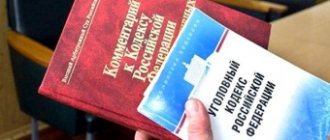Murder under aggravating circumstances, committed intentionally, according to the Criminal Code of the Russian Federation, Part 2 of Art.
105 is subject to criminal liability. The court imposes a punishment on the guilty person for this offense, which, taking into account the qualifications, may consist of imprisonment for both a short period and a longer period. Also in some cases the death penalty or life imprisonment is used. Multi-channel free hotline Legal advice on criminal law. Every day from 9.00 to 21.00
Moscow and region: +7 (495) 662-44-36
St. Petersburg: +7 (812) 449-43-40
Aggravating circumstances
The concept of “aggravating circumstances” is used exclusively in criminal proceedings. Murder is considered to be a specific action, which is always committed with purpose and motive, and inaction. The exception is homicide by negligence. The Criminal Code of the Russian Federation (CC RF) specifies the concepts of various types of murder.
Each offense is individual. When assigning punishment for aggravated murder, the picture of the crime is taken into account, which allows a fair punishment to be applied.
Article 63 of the Criminal Code of Russia indicates circumstances that aggravate the punishment of the defendant:
- Recidivism of offenses, repetition of their commission.
- A serious consequence as a result of the lawlessness committed.
- The commission of an offense by a group of citizens who have entered into a conspiracy in advance or by an organized gang.
- Involvement in the commission of offenses of citizens with severe mental disorders or who are intoxicated, as well as minors who are not subject to criminal liability due to their infancy.
- Committing an atrocity for political, ideological, racial, national, or religious reasons, because of hatred or enmity.
- Carrying out a crime out of revenge for the lawful activities of an authorized person.
- Purposefulness in concealing one offense in order to facilitate another committed crime.
- Committing a criminal act against a person and his relatives because of his official activities or the performance of a public duty.
- Carrying out an offense against a pregnant woman, a minor or defenseless citizen, as well as a person who is dependent on the defendant.
- An offense committed with particular cruelty, sadism, mockery, or torture towards the victim.
- Committing an offense with the help of weapons, ammunition, explosives, explosive or simulating devices, specially manufactured technical means, toxic and radioactive substances, medicinal, chemical, pharmacological drugs, using physical force or mental influence.
- Carrying out an atrocity in a state of emergency, natural or social disaster, during mass riots.
- Committing an offense by taking advantage of the trust placed in the defendant because of his position or under a contract.
- Carrying out an offense using the form of documents authorized by the authorities.
- Committing criminal acts by an employee of internal organs.
- An offense committed in relation to a young child by parents or other persons who are charged by law with the responsibility for his upbringing. This applies to teaching staff or other educational staff, medical professionals, social service organizations or other institutions supervising minors.
- Carrying out an offense for the purpose of promoting, justifying and supporting terrorism.
Also, taking into account the degree and nature of the social danger of the offense, the circumstances of its implementation, the personal data of the defendant. The court may recognize the aggravating circumstance of its commission if the perpetrator was at that moment intoxicated or using narcotic or psychotropic substances.
Such circumstances can negatively characterize the personality and actions of the perpetrator. And also play a role not in favor of the defendant and influence the imposition of a more severe sentence.
Characteristics of the crime
Premeditated murder under aggravating circumstances is considered a more dangerous crime. No one has the right to take a person’s life for personal reasons.
An offense may be committed:
- with direct;
- with indirect intent.
If the perpetrator consciously commits an act that can cause harm to another person, this characterizes direct intent.
The manifestation of indirect intent is that the perpetrator did not initially plan the murder, but did not exclude its possibility and deliberately allowed it.
There are often cases when such actions are committed during fights and quarrels that arose due to national, racial, religious prejudices or blood feud or jealousy. Basically, they are classified as murders with hooligan motives, as they are always accompanied by gross violations of public order.
It would also be wrong to separately characterize the circumstance related to the subjective side and to the subject of the murder.
The nature of the circumstances of the subjective side is:
- The motivation of the perpetrator.
- Purposefulness of committing murder.
- The perpetrator was in a state of passion at the time of the murder.
For example, the selfish motivation for committing a murder equally relates to the nature of the subjective side and the subject.
The objective side of the offense is characterized by:
- acts that infringe on any object in the form of action or inaction;
- socially dangerous consequence;
- cause-and-effect relationship of action, inaction, consequences;
- method, location, time, setting, means and weapons with which the crime was committed.
On the objective side, the composition of murder always has a material bias. Other characteristics of this crime are taken into account during the qualification process, subject to their inclusion in the disposition of the relevant norms.
In the current Criminal Code, circumstances aggravating the offense are combined into two groups.
The first provides for paragraphs “a”, “c”, “d”, “d”, “m”, “f”, part 2 of Art. 105 of the Criminal Code of the Russian Federation, qualifying the objective side of the circumstances that aggravate the offense.
The second group contains points “b”, “g”, “h”, “i”, “j”, “l”, part 2 of Art. 105 of the Criminal Code of the Russian Federation, defining the distinctive features of the subjective side that aggravate the circumstances of the murder.
A general description of the circumstances that aggravate the crime is provided by the classification of murder. These circumstances are closely intertwined with the offense.
The Plenum of the Supreme Court of the Russian Federation has a tough position and believes that the use of indirect intent in qualifying an attempted murder is impossible.
PANFYOROV Dmitry Nikolaevich senior lecturer of the department of special training of the Ufa Law Institute of the Ministry of Internal Affairs of the Russian Federation, police lieutenant colonel PUGACHEV Alexey Viktorovich senior lecturer of the department of special training of the Ufa Institute of Law
Modern criminal policy regarding aggravated murder has been influenced by a number of factors. Firstly, in recent years, murder committed under aggravating circumstances has become highly latent - violent attacks of this type are committed at least 2-3 times more than are registered. Secondly, there are difficulties in qualifying these acts in the presence of contradictory judicial practice and ambiguity in theoretical approaches to the issue of criminal legal assessment of the actions of the guilty person.
In order to solve these and a number of other problems, the legislator has repeatedly made changes to the text of the criminal law in order to clarify and systematize the relevant norms, and the Supreme Court of the Russian Federation has given appropriate clarifications on the issues under consideration.
At the same time, it seems that the current state of affairs regarding the issues of qualification and construction of some qualifying features of murder is not indisputable and requires some revision.
- Murder of two or more persons. This act is provided for in paragraph “a” of Part 2 of Art. 105 of the Criminal Code of the Russian Federation. For a long time, the criminal law doctrine proceeded from the fact that this type of qualified murder existed as an alternative to repeated cases of deprivation of life, and provided for the unity of intent of the perpetrator to deprive the lives of several persons. The actions of the perpetrator were considered as a single ongoing crime.
Taking into account changes in criminal legislation related to the revision of the provisions of the institution of multiple crimes, repetition was excluded from the text of the criminal law, and the totality of crimes was expanded.
In connection with the above, the law enforcement officer responded to this problem in relation to the murder of two or more persons, but not immediately.
Only by Resolution of the Plenum of the Supreme Court of the Russian Federation of April 3, 2008 No. 4, a change was made to the previous edition of paragraph 5 of Resolution No. 1 of January 27, 1999 “On judicial practice in murder cases (Article 105 of the Criminal Code of the Russian Federation).”
Currently, paragraph 5 of this Resolution is as follows: “In accordance with the provisions of Part 1 of Art. 17 of the Criminal Code of the Russian Federation, the murder of two or more persons, committed simultaneously or at different times, does not form a set of crimes and is subject to qualification under paragraph “a” of Part 2 of Art. 105 of the Criminal Code of the Russian Federation, and if there are grounds for this, also under other points of part 2 of this article, provided that the perpetrator has not previously been convicted of any of these murders.”
On the one hand, it is difficult to disagree with this position, since, as V.N. Titov, the key when assessing the behavior of a serial killer should not be intent, but the life of a particular person.
Based on the provisions provided for in Part 1 of Art. 17 of the Criminal Code of the Russian Federation that there is no totality of crimes if the commission of two or more crimes is provided for by articles
According to the special part of the Criminal Code of the Russian Federation, as a circumstance entailing a more severe punishment, the actions of the perpetrator who took the lives of several people should be considered as a qualified type of murder - the murder of two or more persons, provided for in paragraph “a” of Part 2 of Art. 105 of the Criminal Code of the Russian Federation.
On the other hand, the Supreme Court of the Russian Federation rightly considered that the provisions of Part 1 of Art. 17 of the Criminal Code of the Russian Federation in relation to a crime (in this case, murder) of several persons must be clearly regarded as a qualified sign of murder, but the question arises: will this not lead to the “depersonalization” of all those cases of deprivation of life that took place in the behavior of the guilty person?
Each crime, including murder, must have its own independent legal assessment. In essence, the law enforcement officer with the wording “the murder of two or more persons, committed simultaneously or at different times, does not form a set of crimes” indicates that we are talking, as previously said, about the so-called continuing crime. Theoretical provisions in this regard nullify the desire of the Plenum of the Supreme Court of the Russian Federation to strengthen criminal liability for such behavior of the guilty person, since each of the murders committed by the guilty person must, according to the logic of the law enforcement officer, be part of a “chain of murders”.
The existence of an existing problem is also indicated by the Supreme Court of the Russian Federation itself, which made changes to paragraph. 2, paragraph 5 of Resolution No. 1 of January 27, 1999, provided the following: “The murder of one person and the attempted murder of another cannot be considered as a completed crime - the murder of two persons. In such cases, regardless of the sequence of criminal actions, the act should be qualified under Part 1 or Part 2 of Art. 105 and according to Part 3 of Art. 30 and paragraph “a”, part 2, art. 105 of the Criminal Code of the Russian Federation."
Thus, there is an obvious contradiction in the text of the Resolution. On the one hand, it is indicated that the murder of two or more persons is a single ongoing crime, on the other hand, if it is associated with at least one case of unfinished murder, then we are talking about both aggregation and an unfinished single crime.
It seems that this theoretical and applied problem should find its unambiguous solution. Either the law enforcement officer must recognize the murder of one person and the attempted murder of another as an unfinished ongoing crime - an attempted murder of two persons; or reject the fact that the murder of two or more persons excludes the totality of crimes and recognize the need to impute the perpetrator in all such cases (completed murders) - independently of each individual episode in the aggregate, as well as clause “a” of Part 2 of Art. 105 of the Criminal Code of the Russian Federation.
It seems that the first position seems more fair, since it allows for a systematic interpretation of the provisions of Part 1 of Art. 17 and art. 30 and paragraph “a”, part 2, art. 105 of the Criminal Code of the Russian Federation. In the second case, there is a so-called double imputation, which, as is known, has no place in the criminal law, based on the principle of justice (Part 2 of Article 6 of the Criminal Code of the Russian Federation).
At the same time, this does not generally solve the problem of the existing interpretation by the Plenum of the Supreme Court of the Russian Federation of the provisions of Part 1 of Art. 17 of the Criminal Code of the Russian Federation, since in this form the rule of independent assessment of each criminal act is violated, which is unacceptable, both from a legal and procedural point of view. Consequently, the legislator should reconsider the exceptions contained in the text of Part 1 of Art. 17 of the Criminal Code of the Russian Federation in relation to a set of crimes.
- Murder of a minor (clause “c” of Part 2 of Article 105 of the Criminal Code of the Russian Federation).
For a long time, the young age of the victim was not considered as an independent qualifying sign of murder. Until recently, it was actually an integral part of the “helpless state” symptom.
In paragraph 7 of the Resolution of the Plenum of the Supreme Court No. 1 of January 27, 1999 “On judicial practice in murder cases (Article 105 of the Criminal Code of the Russian Federation)” it is stated that “under paragraph “c” of Part 2 of Art. 105 of the Criminal Code of the Russian Federation (murder of a person known to the perpetrator to be in a helpless state) should qualify the intentional infliction of death on a victim who is unable, due to a physical or mental state, to defend himself or to provide active resistance to the perpetrator, when the latter, while committing the murder, is aware of this circumstance. Persons in a helpless state may include, in particular, seriously ill and elderly people, young children, people suffering from mental disorders that deprive them of the ability to correctly perceive what is happening.”
Changes introduced on July 27, 2009 by Federal Law No. 215-FZ identified the murder of a minor as an independent qualifying feature provided for in paragraph “c” of Part 2 of Art. 105 of the Criminal Code of the Russian Federation, along with a helpless state. Moreover, the legislator, in relation to minors, did not include in the text of the law an indication of the sign of “knowledge”. This approach indicates that in order to impute this characteristic, it is necessary that the murder victim is under 14 years of age. It does not matter whether the guilty person was aware of this fact or not.
This provision indicates the desire of the legislator, on the one hand, to provide additional protection for the interests of minors; on the other hand, to strengthen criminal liability for attacks on the lives of these persons.
From a legal position, we are talking about the so-called objective imputation in relation to the murderer, since, regardless of his awareness of the signs of the victim characterizing his age, he is charged with a qualifying circumstance of murder. Despite the fact that objective imputation is unacceptable (Part 2 of Article 5 of the Criminal Code of the Russian Federation), one should agree with A.I. Martsev is that it, as an exception to the rules, has the right to exist, while the legislator should strive to limit the possibilities of its application.
By making such changes, the legislator “stimulates” the objective imputation of signs of crimes characterized by an increased degree of public danger.
At the same time, changes related to the exclusion of the indication of the sign of “knowledge” in relation to the age of the victim were introduced by the above-mentioned Federal Law of July 27, 2009 No. 215-FZ and in Art. 131 and 132 of the Criminal Code of the Russian Federation.
Giving appropriate explanations in this regard, the Plenum of the Supreme Court of the Russian Federation in Resolution No. 16 of December 4, 2014 “On judicial practice in cases of crimes against sexual integrity and sexual freedom of the individual” noted that when applying the law on criminal liability for committing crimes provided for Art. Art. 131 and 132 of the Criminal Code of the Russian Federation, in relation to minors, courts should proceed from the fact that the qualification of crimes on the relevant grounds “is possible only in cases where the perpetrator knew or admitted that the victim was a person under eighteen years of age or another age, specifically specified in the disposition of the article of the Special Part of the Criminal Code of the Russian Federation.”
As noted by V.B. Poezzhalov and A.E. Linkevich, the Plenum of the Supreme Court of the Russian Federation in this resolution actually says that the changes made regarding the exclusion of the sign of “knowledge” from the text of the criminal law should not be taken into account, but should be guided by the content of the intent of the perpetrator.
Consequently, it should be concluded that the desire of the legislator to “strengthen responsibility” for the murder of a minor using “objective imputation” is not realized in reality (cannot be realized), since the Plenum, using a restrictive interpretation of the law, narrows the scope of the legal norm. At the same time, it seems advisable that the corresponding explanations be given in the Resolution of the Plenum of the Supreme Court of the Russian Federation No. 1 of January 27, 1999 “On judicial practice in murder cases (Article 105 of the Criminal Code of the Russian Federation)” in order to uniform judicial practice and prevent discrepancies in decision-making in similar cases.
- Murder associated with the commission of a particular crime.
There are a lot of these types of qualified murder. The legislator does not highlight them in one paragraph of Part 2 of Art. 105 of the Criminal Code of the Russian Federation. Murder associated with kidnapping is provided for in paragraph “c”, murder associated with robbery, extortion or banditry is indicated in paragraph “h”, and murder associated with rape or violent acts of a sexual nature is provided for in paragraph “k” h .2 tbsp. 105 of the Criminal Code of the Russian Federation.
As G.N. Borzenkov notes, the issue of constructing and qualifying murders associated with the commission of the above crimes has always been controversial. At the same time, the presence of such structures, despite all their complexity, was justified by time. Courts at various levels have developed a fairly large volume of judicial practice, which is systematized by the Supreme Court of the Russian Federation. Criminal acts of the perpetrator in all cases under consideration in accordance with paragraphs. 7, 11, 13 Resolution of the Plenum of the Supreme Court of the Russian Federation of January 27, 1999 No. 1 “On judicial practice in murder cases” should be qualified according to the totality of the corresponding paragraph of Part 2 of Art. 105 of the Criminal Code of the Russian Federation (“c”, “z” or “k”) and articles of the Criminal Code of the Russian Federation providing for liability for kidnapping (Article 125 of the Criminal Code of the Russian Federation), robbery (Article 162 of the Criminal Code of the Russian Federation), extortion (Article 163 of the Criminal Code of the Russian Federation) ), banditry (Article 131 of the Criminal Code of the Russian Federation), rape (Article 131 of the Criminal Code of the Russian Federation) or violent acts of a sexual nature (Article 132 of the Criminal Code of the Russian Federation).
The peculiarity of this kind of qualification is based on the priority of human life over other goods and on the fact that, on the one hand, no act can cover the murder of another person, on the other hand, murder cannot cover attacks on other objects of criminal legal protection. In this case, the feature “conjugation” should be assessed as “existing alongside”, “existing independently”.
Federal Law No. 321-FZ of December 30, 2008
Part 3 Art. 205 “Terrorist act”, Part 4 of Art. 206 of the Criminal Code of the Russian Federation “Hostage-taking” and Part 3 of Art. 281 “Sabotage”, especially aggravating circumstances were established, increasing the punishment for the relevant acts if they “resulted in the intentional causing of death to a person.”
These provisions have changed the approach to the construction and qualification of murder and related crimes that has existed for many years. In fact, the legislator reconsidered the place of the rule on murder in the system of criminal law regulations. In this regard, the Plenum of the Supreme Court of the Russian Federation in paragraph 9 of Resolution No. 1 of February 9, 2012 “On some issues of judicial practice in criminal cases of crimes of a terrorist nature” indicated that “in the event that a terrorist act entailed the intentional death of a person (or two or more persons), the act is covered by paragraph “b” of Part 3 of Art. 205 of the Criminal Code of the Russian Federation and additional qualifications under Art. 105 of the Criminal Code of the Russian Federation is not required.”
The construction of “involvement,” in relation to murder, seems to be more preferable compared to the formulation “resulted in the intentional causing of death to a person.”
Firstly, one act cannot entail another act. There are no such legislative structures in any other criminal law norm (except for Part 3 of Article 205, Part 4 of Article 206 and Part 3 of Article 281 of the Criminal Code of the Russian Federation). An act may cause consequences, and according to the logic of the legislator, a terrorist act, hostage-taking or sabotage may lead to murder, that is, another act. In this regard, the legislative structure in which, say, the taking of a hostage entails the “deliberate infliction of death on a person” looks quite controversial. It is more fair to say that the hostage-taking involved murder.
Secondly, if the legislator chose a “different” approach in comparison with the already established approach to formulating the rules for assessing murder in the commission of other criminal acts, then why did this only apply to hostage-taking, a terrorist act and sabotage? It seems that it would be necessary to provide an indication of these acts as involving murder in Part 2 of Art. 105 of the Criminal Code of the Russian Federation.
Thirdly, the exclusion of additional qualifications under Art. 105 of the Criminal Code of the Russian Federation in the case of committing a terrorist act, hostage-taking or sabotage, if the court does not impose a sentence of life imprisonment, excludes the totality of crimes, and, therefore, the imposed punishment may be lower than in the case of the perpetrator committing acts “involving murder”, which not entirely fair from the point of view of individualization of punishment.
In connection with the above, it seems appropriate to unify and systematize criminal law regulations regarding cases when, in the process of committing criminal acts, the perpetrator commits murder. For these purposes, it is necessary to provide an indication of the connection between murder and elements of a terrorist act, hostage-taking and sabotage, by providing an indication in one of the paragraphs of Part 2 of Art. 105 of the Criminal Code of the Russian Federation.
| < previous | next > |
Responsibility for murder
A crime directed against human life is called murder.
This is reflected in the legislation. It specifies the penalties applicable to citizens who commit this offense. There are different life situations when a person does not have time to control his emotions that influenced the commission of a crime. Article 105 of the Criminal Code of the Russian Federation consists of two parts. The first talks about committing a murder without aggravating circumstances. The culprit convicted under this part is sentenced to imprisonment for 6–15 years.
The second part of the article indicates the circumstances under which more severe punishments are applied. The perpetrator is brought to justice for murder under certain circumstances that make his guilt even more serious.
The defendant may be punished:
- Imprisonment for 8–20 years.
- Life imprisonment.
- Imposing the death penalty.
The law sees an increased social threat in murders committed under circumstances that aggravate the guilt; because of this, long sentences are applied to the perpetrators in such cases.
But there are situations when murder is committed through negligence. This applies to Article 109 of the Criminal Code of the Russian Federation; this offense is classified separately from Art. 105 of the Criminal Code of the Russian Federation.
In this case, it is necessary to conduct an accurate study of causing death to a person. Was it really random? Could the defendant have foreseen the fatal outcome? Did he take any measures to avoid tragedy?
In case of deprivation of life through negligence, the criminal may foresee a negative consequence. But due to criminal frivolity, he does not attach any importance to this or, due to criminal negligence, he does not think about the consequences.
This article provides for penalties:
- if an action or inaction leads to the death of two or more people, 4 years of imprisonment are imposed;
- when the culprit does not fulfill his official duties, a punishment of up to 3 years follows;
- in addition, under Article 109 of the Criminal Code of the Russian Federation, restriction of freedom or forced labor for a period of 2 years may be imposed.
Therefore, it is important to correctly classify crimes related to murder during the preliminary investigation.
Responsibility
Criminal liability for murder with the classification criteria that were discussed above is established in accordance with the same part 2 of Article 105 of the Criminal Code of the Russian Federation.
It consists of the following:
shall be punishable by imprisonment for a term of eight to twenty years with restriction of freedom for a term of one to two years, or life imprisonment, or the death penalty.
The death penalty is not applied in the Russian Federation, so the maximum penalty is life imprisonment.









